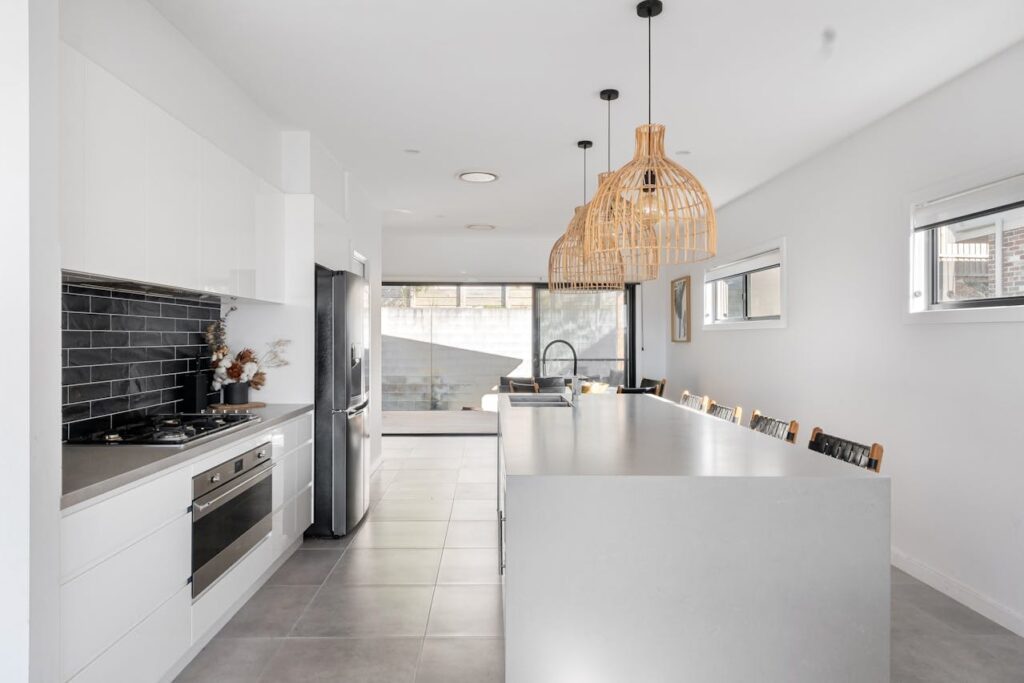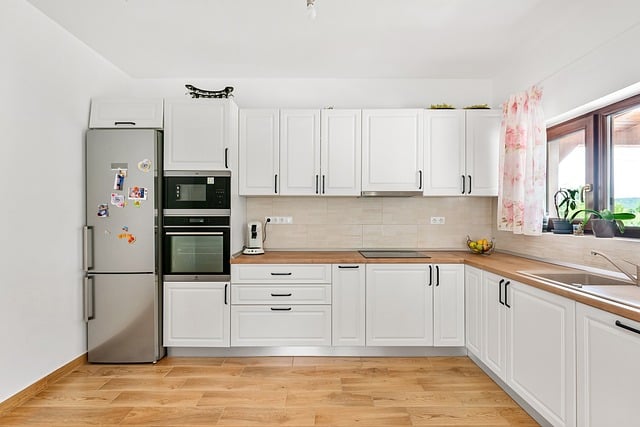In the quest for safe and practical living spaces, slip-resistant kitchen flooring emerges as a crucial necessity for elderly homeowners. With a focus on enhancing safety and minimizing the risk of falls, this flooring solution offers peace of mind and comfort. Especially designed to provide stability and reduce accidents, slip-resistant floors cater to the unique needs of aging individuals, ensuring a secure environment in one of the most frequented areas of the home. By combining functionality with style, these flooring options not only prioritize safety but also contribute to the overall aesthetics of the kitchen space, making it a valuable investment for homeowners seeking both security and sophistication.
Importance of Safe Flooring
Reduced Risk
Elderly homeowners face an increased risk of slips and falls due to age-related factors like reduced balance and mobility. These accidents can lead to severe injuries, impacting their quality of life.
Safe flooring is crucial in mitigating these risks by providing enhanced traction and stability. Materials like non-slip tiles or vinyl with textured surfaces can significantly reduce the likelihood of accidents.
Comfortable Living
Secure flooring not only ensures safety but also contributes to a comfortable living environment for the elderly. It offers a stable surface for walking aids like canes or walkers, promoting independence and confidence in movement.
Adequate cushioning in flooring materials such as rubber or cork can help absorb impact in case of a fall, reducing the severity of injuries. These materials are softer underfoot, making standing for long periods more comfortable for seniors.
Choosing the Right Non-Slip Floors
Types of Non-Slip Flooring
Elderly homeowners must opt for slip–resistant kitchen flooring to prevent accidents. Vinyl and rubber floors are excellent choices due to their high traction.
Vinyl flooring offers a soft surface that reduces the impact of falls, while rubber flooring provides durability and is easy to maintain.
Factors to Consider
When selecting non-slip floors, consider ease of cleaning, comfort, and longevity. Ensure the flooring material is water–resistant and has a textured surface for better grip.
- Pros:
- Reduces the risk of slips and falls
- Easy to clean and maintain
- Provides comfort for prolonged standing
- Cons:
- Initial installation cost might be higher
- Some options may lack aesthetic appeal
Tips for Choosing Non-Slip Floors
- Prioritize safety over style by opting for functionality rather than aesthetics.
- Look for flooring with a high coefficient of friction to enhance traction.
- Consider consulting with professionals to determine the most suitable option based on specific needs.
Types of Anti-Slip Flooring
Rubber
Rubber flooring is a popular choice for elderly homeowners due to its excellent traction properties. It provides a cushioned surface that reduces the risk of slips and falls. Rubber flooring is durable, easy to clean, and absorbs sound, making it ideal for kitchens.
Vinyl
Vinyl flooring offers a wide range of design options while still being highly slip-resistant. Its waterproof nature makes it perfect for kitchen areas where spills are common. Vinyl is also comfortable to stand on for extended periods, reducing fatigue in elderly individuals.
Cork
Cork flooring is known for its natural anti–slip properties, making it a safe choice for kitchens. It is soft underfoot, providing a comfortable surface that is gentle on joints. Cork is also eco-friendly and hypoallergenic, catering to the health needs of elderly homeowners.
How They Cater to Specific Needs
- Rubber flooring suits those looking for maximum grip and durability.
- Vinyl flooring appeals to individuals seeking versatility in design and maintenance ease.
- Cork flooring caters to those prioritizing comfort, sustainability, and allergen-free environments.
Installation Tips for Safety
Proper Preparation
To begin, thoroughly clean the kitchen floor to remove any dirt or debris that could affect the new flooring’s adhesion. Ensure the surface is dry before proceeding with the installation process.
Choosing the Right Flooring
Select slip–resistant flooring that is specifically designed for kitchens. Look for materials like vinyl, rubber, or textured tiles that provide excellent traction to prevent slips and falls.
Adhering to Guidelines
Follow the manufacturer’s instructions carefully when installing the slip-resistant flooring. Adhere to recommended adhesives and installation techniques to guarantee a secure and durable outcome.
Testimonials from Experts
Consult with flooring specialists or contractors who have experience in installing slip-resistant flooring. Their expertise can provide valuable insights and recommendations for a successful installation.
Ensuring Stability
Prioritize stability by ensuring that the subfloor is level and smooth before laying down the new slip-resistant flooring. Any unevenness could compromise the safety and longevity of the installation.
Final Inspections
After completing the installation, perform a thorough inspection to check for any loose edges or corners. Securely fasten all edges to prevent tripping hazards for elderly homeowners.
Cleaning and Maintenance
Easy Cleaning Methods
Regular maintenance is crucial for preserving the slip-resistant properties of kitchen flooring. To clean, use a mixture of warm water and mild detergent. Scrub gently with a soft-bristled brush to avoid damaging the surface.
Remember to avoid harsh chemicals or abrasive tools that can wear down the slip-resistant coating over time. Once cleaned, ensure the floor is completely dry before allowing foot traffic to prevent slips or falls.
Importance of Regular Maintenance
Maintaining slip-resistant kitchen flooring is essential for preventing accidents, especially for elderly homeowners. Regular cleaning helps remove dirt and grime that can reduce the effectiveness of the non-slip surface.
By keeping the flooring clean and well-maintained, you are ensuring a safe environment for individuals prone to slips and falls. This proactive approach significantly reduces the risk of injuries in busy kitchens.
Tips for Safety
For elderly individuals, it’s vital to incorporate safety measures into daily routines. Place rugs with non-slip backings near sinks and stoves to provide extra traction in high-traffic areas. Encourage wearing supportive footwear indoors to enhance stability.
Consider using gentle cleaning solutions that won’t compromise the slip-resistant properties of the flooring. Implementing these small changes can make a significant difference in reducing accidents and promoting overall safety at home.
Cost Considerations
Initial Investment
Investing in slip–resistant kitchen flooring may seem costly at first, but the long–term benefits far outweigh the initial cost. The expense of installing such flooring is a small price to pay compared to the potential risks and costs associated with falls among elderly homeowners.
The initial investment in slip-resistant flooring can significantly reduce the risk of falls in kitchens, which are common areas for accidents among the elderly. By prioritizing safety through this investment, homeowners can prevent costly medical bills and potential long-term healthcare needs resulting from fall-related injuries.
Cost-Effective Options
When considering slip-resistant kitchen flooring, there are various cost–effective options available that cater to different budgets. Vinyl and linoleum floors are affordable choices that offer excellent slip resistance. These options not only enhance safety but also provide durability and easy maintenance, making them ideal for elderly homeowners.
Installing slip-resistant flooring is a proactive measure that addresses the specific needs of elderly individuals living independently or with limited mobility. By taking into account these needs and investing in suitable flooring solutions, homeowners can create a safer environment that reduces the risk of falls and promotes overall well-being.
Flooring Alternatives
Linoleum
Linoleum flooring is a good option for slip-resistant kitchen floors. It offers durability and easy maintenance.
It provides a soft surface that reduces the risk of injuries from falls, making it ideal for elderly homeowners.
Vinyl
Vinyl flooring is another great option known for its slip-resistant properties. It is affordable and comes in various designs.
This type of flooring is waterproof, making it suitable for kitchens where spills are common.
Cork
Cork flooring is a unique choice that combines natural slip resistance with eco-friendliness.
It has a soft texture, making it comfortable to stand on for extended periods.
Pros and Cons
Pros:
- Easy to clean and maintain
- Durable and long-lasting
- Various design options available
Cons:
- May require professional installation
- Can be prone to scratches
- Limited moisture resistance compared to other materials
Safety and Aesthetics
Innovative flooring materials like textured tiles or rubberized flooring can provide both safety and aesthetics in kitchen spaces.
These materials offer enhanced grip while adding a modern touch to the overall kitchen design.
Benefits of Slip-Resistant Floors
Enhanced Safety
Slip-resistant kitchen flooring significantly reduces the risk of accidents caused by slippery surfaces. By providing better traction, these floors help prevent falls, especially common among elderly individuals.
Independence Boost
For elderly homeowners, slip-resistant floors play a crucial role in maintaining independence. With a reduced fear of slipping, seniors can move around their kitchens confidently and without assistance.
Peace of Mind
The installation of slip-resistant flooring brings peace of mind to elderly homeowners and their families. Knowing that the risk of slipping is minimized, they can go about their daily activities without constant worry.
Final Remarks
Ensuring your kitchen flooring is slip-resistant is crucial for the safety of elderly homeowners. By choosing the right non-slip floors and following installation tips, you can create a secure environment that minimizes the risk of accidents. Regular cleaning and maintenance will help preserve the effectiveness of your slip-resistant flooring, providing long-term benefits and peace of mind. Consider the cost implications and explore different flooring alternatives to find the best fit for your needs.
Investing in slip-resistant kitchen flooring is not just about aesthetics but about creating a safe space for you and your loved ones. Take action today to enhance the safety of your home environment. Your proactive approach can make a significant difference in preventing slips and falls, ensuring a secure and comfortable living space for everyone.
Transform Your Space with Kitchen Flooring Upgrades by Red White & Blue Construction!
Considering a kitchen flooring upgrade as part of your home renovation in Lafayette, CA? Red White & Blue Construction is your premier choice for expert kitchen flooring services! Specializing in the meticulous planning and execution of comprehensive kitchen flooring enhancements, we tailor our strategies to meet your specific needs and visions. Known for our expertise in kitchen flooring, we are dedicated to transforming your kitchen into a more stylish, functional, and modern cooking space, with every aspect carefully planned and executed to exceed your expectations. Our esteemed reputation throughout the Bay Area stands as a testament to our commitment to precision, quality, and the high standards we uphold in every project phase.
At Red White & Blue Construction, our goal is to do more than just update your floors; we aim to enhance your entire home renovation experience. With our detailed planning, transparent pricing, and unparalleled customer service, choosing us for your kitchen flooring upgrade means embarking on a smooth, efficient renovation journey. Opt for Red White & Blue Construction for all your kitchen flooring needs and take the first step towards a more stylish and functional kitchen. Contact us today to get started!
Disclaimer
The materials available on this website are for informational and entertainment purposes only and not to provide advice. You should obtain advice concerning any particular issue or problem from a professional. You should not act or refrain from acting based on any content included in this site without seeking legal or other professional advice. The information presented on this website may reflect only some of the current building developments. No action should be taken in reliance on the information on this website. We disclaim all liability concerning actions taken or not taken based on any or all of the contents of this site to the fullest extent permitted by law.





